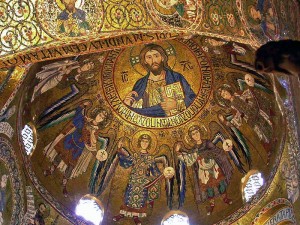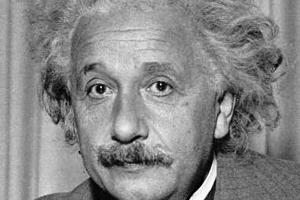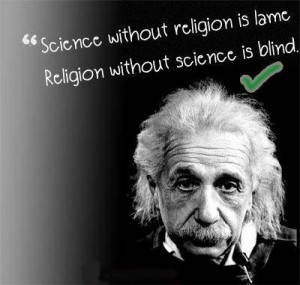From The Rosicrucian Cosmo-Conception
By Max Heindel
Jehovah came with His Angel and Archangels and made the first great division into Races, giving to each group the guiding influence of a Race-spirit—an Archangel. For each Ego He appointed one of the Angels to act as guardian until the individual spirit had grown strong enough to become emancipated from all outside influence.

It is a notable fact that man and his religions have evolved side by side and in an equal degree. The earliest religion of any Race is found to be as savage as the people governed by it and as they become more civilized, their religions become more and more humane and in harmony with higher ideals.
From this fact materialists have drawn the inference that no religion has a higher origin than man itself. Their investigations into early history have resulted in a conviction that, as man progressed, he civilized his God and fashioned Him after his own pattern.
This reasoning is defective, because it fails to take into account that man is not the body, but an indwelling spirit, an Ego who uses the body with ever-increasing facility as evolution progresses.
There is no doubt that the law for the body is “The Survival of the Fittest.” The law for the evolution of the spirit demands “Sacrifice.” As long as man believes that “Might is Right,” the Form prospers and waxes strong, because all obstacles are swept out of the way regardless of others. If the body were all, that manner of life would be the only one possible for man. He would be altogether incapable of any regard for others and would forcibly resist any attempt to encroach upon what he considered his rights—the right of the stronger, which is the sole standard of justice under the law of the Survival of the Fittest. He would be quite regardless of his fellow beings; absolutely insensible to any force from without that tended to make him act in any manner not conducive to his own momentary pleasure.
It is manifest, then, that whatever urges man toward a higher standard of conduct in his dealing with others must come from within, and from a source which is not identical with the body, otherwise it would not strive with the body and often prevail against its most obvious interests. Moreover, it must be a stronger force than that of the body, or it could not succeed in overcoming its desires and compelling it to make sacrifices for those who are physically weaker.
That such a force exists, surely no one will deny. We have come to that stage in our advancement where, instead of seeing in physical weakness an opportunity for easy prey, we recognize in the very frailty of another a valid claim upon our protection. Selfishness is being slowly but surely routed by Altruism.
Nature is sure to accomplish her purposes. Though slow, her progress is orderly and certain. In the breast of every man this force of Altruism works as a leaven. It is transforming the savage into the civilized man, and will in time transform the latter into a God. [The Rosicrucian Cosmo-Conception by Max Heindel 367 – 369]
It must not be thought that these successive steps were taken easily, nor without rebellion and lapses upon the part of primitive man. Selfishness is ingrained in the lower nature even unto this day, and there must have been many lapses and much backsliding. We have in the Jewish Bible good examples of how man forgot, and had to be patiently and persistently “prodded” again and again by the Tribal God. Only the visitations of a long-suffering Race-spirit were potent, at times, in bringing him back to the law—that law very few people have even yet learned to obey.
There are always pioneers, however, who require something higher. When they become sufficiently numerous, a new step in evolution is taken, so that several gradations always exist. There came a time, nearly two thousand years ago, when the most advanced of humanity were ready to take another step forward, and learn the religion of living a good life for the sake of future reward in a state if existence in which they must have faith. [RCC 372 – 373]
Christ came to prepare the way for the emancipation of humanity from the guidance of differentiating Race and Family-spirit, and to unite the whole human family in One Universal Brotherhood. [RCC 353]

Palermo Capella Palatina
All other religions have been but leading up to the Christian religion. They were Race Religions and contain only in part that which Christianity has in fuller measure. The real Esoteric Christianity has not yet been taught publicly, nor will it be so taught until humanity has passed the materialistic stage and becomes fitted to receive it. The laws of Rebirth and Consequence have been secretly taught all the time, but, by the direct Command of Christ Himself, as we shall see, these two laws have not been publicly taught in the Western world for the past two thousand years. [RCC 164]
Christ came to reunite the separated races in bonds of peace and good will, wherein all will willingly and consciously follow the law of Love.
The present Christianity is not even a shadow of the true religion of Christ. That will remain in abeyance until all race feelings shall have been overcome. In the Sixth Epoch there will be but one Universal Brotherhood, under the Leadership of the Returned Christ, but the day and the hour no man knows, for it is not fixed, but depends upon how soon a sufficient number of people shall have commenced to live the life of Fellowship and Love, which is to be the hall-mark of the new dispensation. [RCC 360]

Christ Crowned With Thorns – 1500 Botticelli
Is it strange that people find it difficult to realize this high ideal of continued well-doing, made doubly hard by the fact that self-interest is entirely ignored? Sacrifice is demanded with no positive assurance of any reward. Surely it is much to the credit of humanity that so much altruism is practiced and that it is constantly increasing. The wise Leaders, knowing the frailness of the spirit to cope with the selfish instincts of the body, and the dangers of despondency in the face of such standards of conduct, gave another uplifting impulse when they incorporated in the new religion the doctrine of “vicarious Atonement.”
This idea is scouted by some very advanced philosophers, and the law of “Consequence” made paramount. If it so happens that the reader agrees with these philosophers, we request that he await the explanation herein set forth, showing how both are part of the scheme of upliftment. Suffice it to say, for the present, that this doctrine of atonement gives many an earnest soul the strength to strive and, in spite of repeated failures, to bring the lower nature under subjection. Let it be remembered that, for reasons given when the laws of Rebirth and Consequence were discussed, western humanity knew practically nothing of these laws. With such a great ideal before them as the Christ, and believing they had but a few short years in which to attain to such a high degree of development as this, would it not have been the greatest imaginable cruelty to leave them without help? Therefore, the GREAT SACRIFICE on Calvary—while it also served other purposes, as will be shown—become rightfully the Beacon of Hope for every earnest soul who is striving to achieve the impossible; to attain, in one short life, to the perfection demanded by the Christian religion. [RCC 374]
All Race-religions are of the Holy Spirit. They are insufficient, because they are based on law, which makes for sin and brings death, pain and sorrow.
All Race-spirits know this, and realize that their religions are merely steps to something better. This is shown by the fact that all Race-religions, without exception, point to One Who is to come. The religion of the Persians pointed to Mithras; of the Chaldeans to Tammuz. The old Norse Gods foresaw the approach of “The Twilight of the Gods,” when Sutr, the bright Sun-spirit, shall supersede them and a new and fairer order be established on “Gimle,” the regenerated earth. The Egyptians waited for Horus, the newborn Sun. Mithras and Tammuz are also symbolized as Solar orbs and all the principal Temples were built facing the East, that the rays of the rising Sun might shine directly through the open doors; even Saint Peter’s at Rome is so placed. All these facts show that it was generally known that the One Who was to come was a Sun-spirit and was to save humanity from the separative influences necessarily contained in all Race-religions.
These religions were steps which it was necessary for mankind to take to prepare for the advent of Christ. Man must first cultivate a “self” before he can become really unselfish and understand the higher phase of Universal Brotherhood—unity of purpose and interest—for which Christ laid the foundation at His first coming, and which He will make living realities when He returns.
As the fundamental principle of a Race-religion is separation, inculcating self-seeking at the expense of other men and nations, it is evident that if the principle is carried to its ultimate conclusion it must necessarily have an increasingly destructive tendency and finally frustrate evolution, unless succeeded by a more constructive religion.
Therefore the separative religions of the Holy Spirit must give place to the unifying religion of the Son, which is the Christian religion.

Jesus Mocked By The Soldiers – Manet
Law must give place to Love, and the separate Races and Nations be united in one Universal Brotherhood, with Christ as the Eldest Brother.
The Christian religion has not yet had time to accomplish this great object. Man is still in the toils of the dominant Race-spirit and the ideals of Christianity are yet too high for him. The intellect can see some of the beauties, and readily admits that we should love our enemies, but the passions of the desire body are still too strong. The law of the Race-spirit being “An eye for an eye,” the Feeling is “I’ll get even!” The heart prays for Love; the desire body hopes for Revenge. The intellect sees, in the abstract, the beauty of loving one’s enemies but in concrete cases it allies itself with the vengeful feeling of the desire body, pleading, as an excuse for “getting even,” that “the social organism must be protected.” [RCC 384 – 385]
If we have become aroused from the usual lethargy and are anxious to progress, the question naturally arises, what must I do?
Without well-kept tools the mechanic can do no effective work; similarly, the instruments of the Ego must be cleansed and sharpened; then we may commence work to some purpose. As one works with those wonderful tools they themselves improve with proper use and become more and more efficient to aid in the work. The object of this work is Union with the Higher Self.
There are three steps by which this work conquers the lower nature, but they are not completely taken one after the other. In a certain sense they go together, so that at the present stage the first receives the most attention, the second less, and the third least of all. In time, when the first step has been wholly taken, naturally more attention can be paid to the other two.
There are three helps given in attaining these three stages. They can be seen in the outside world, where the great Leaders of humanity have placed them.
The first help is Race religions, which by aiding humanity to overcome the desire body, prepare it for union with the Holy Spirit.
The full operation of this help was seen on the Day of Pentecost. As the Holy Spirit is the Race God, all languages are expressions of it. That is why the apostles, when fully united and filled with the Holy Spirit, spoke with different tongues and were able to convince their hearers. Their desire bodies had been sufficiently purified to bring about the wished-for union and this is an earnest of what the disciple will one day attain to–the power to speak all tongues. It may also be cited as a modern, historical example, that the Comte de St. Germain (who was one of the later incarnations of Christian Rosenkreuz the founder of our sacred Order), spoke all languages, so that all to whom he spoke thought he belonged to the same nation as they. He also had achieved union with the Holy Spirit. [RCC 433 – 434]

St. Joseph’s Church Chapel Window at Zabrz
The purpose of the religion of the Son, Christ, is to further uplift mankind by forming it into a Universal Brotherhood of separate individuals.
The ideal of the Religion of The Father will be the elimination of all separateness, merging all into One, so that there will be no “I” nor “Thou,” but all will be One in reality. This will not come to pass while we are still inhabitants of the physical Earth, but in a future state where we shall realize our unity with all, each having access to all the knowledge garnered by each separate individual. Just as the single facet of a diamond has access to all the light that comes through each of the other facets, is one with them, yet bounded by lines which give it a certain individuality without separateness, so will the individual spirit retain the memory of its particular experiences, while giving to all others the fruits of its individual existence.
These are the steps and stages through which humanity is unconsciously being led. [Max Heindel, RCC 436 – 437]
Tags: Angels, Archangels, Christ, Christianity, Jehovah, Religion, world religions














